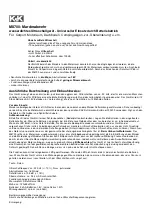
1
DAC-510E-EN-BG
1 Introduction to the DDU-100 Series AED
This User Manual provides information to guide trained operators in the use and maintenance of the
Defibtech
DDU-100
series Semi-Automatic External Defibrillator (“AED”) and its accessories. This
chapter includes an overview of the AED, a discussion of when it should and should not be used, and
information on required operator training.
1.1 Overview
The
DDU-100
AED is a Semi-Automatic External Defibrillator (“AED”) that is designed to be easy to
use, portable and battery powered. It has only two user controls: the ON/OFF and SHOCK buttons.
Voice prompts and visual indicators provide a simple interface for the operator. The
DDU-100
AED is
capable of recording event information including ECG, audio data (optional), and SHOCK/NO-SHOCK
recommendations.
When connected to a patient who is unconscious and not breathing, the
DDU-100
AED performs the
following tasks:
• Prompts the operator to take necessary actions to enable analysis.
• Automatically analyzes the patient’s ECG.
• Determines whether a shockable rhythm is present.
• Charges the defibrillation capacitor and arms the SHOCK button if the AED
detects a shockable rhythm.
• Prompts the operator to press the SHOCK button when the device is ready and a shock is
recommended.
• Delivers a shock once the device has determined a shock is required and the SHOCK button has
been pressed.
• Repeats the process if additional shocks are required.
The Defibtech
DDU-100
AED will
NOT
shock a patient automatically; it will only advise the operator.
The SHOCK button is enabled only when a shockable rhythm is detected and the device is charged
and ready to shock. Charging occurs automatically when the device detects a shockable rhythm. The
operator must press the SHOCK button to initiate defibrillation.
The
DDU-100
AED uses two self-adhesive defibrillation/monitoring pads to monitor ECG signals and,
if necessary, to deliver defibrillation energy to the patient. These pads (also known as electrodes) are
provided in a single-use, disposable package.
The
DDU-100
AED determines proper pad-to-patient contact by monitoring the impedance between
the two pads (impedance varies with the electrical resistance of the patient’s body). Visual and audio
prompts inform the operator of possible problems with patient contact. Voice prompts and visual
indicators communicate the status of the AED and of the patient to the operator. The
DDU-100
AED
has two push-button controls and several LED indicators.
Summary of Contents for Lifeline DCF-100
Page 2: ......
Page 3: ...iii DAC 510E EN BG...
Page 8: ...viii DAC 510E EN BG...
Page 24: ...16 DAC 510E EN BG...
Page 36: ...28 DAC 510E EN BG...
Page 48: ...40 DAC 510E EN BG...
Page 70: ...62 DAC 510E EN BG...
Page 72: ...64 DAC 510E EN BG...









































